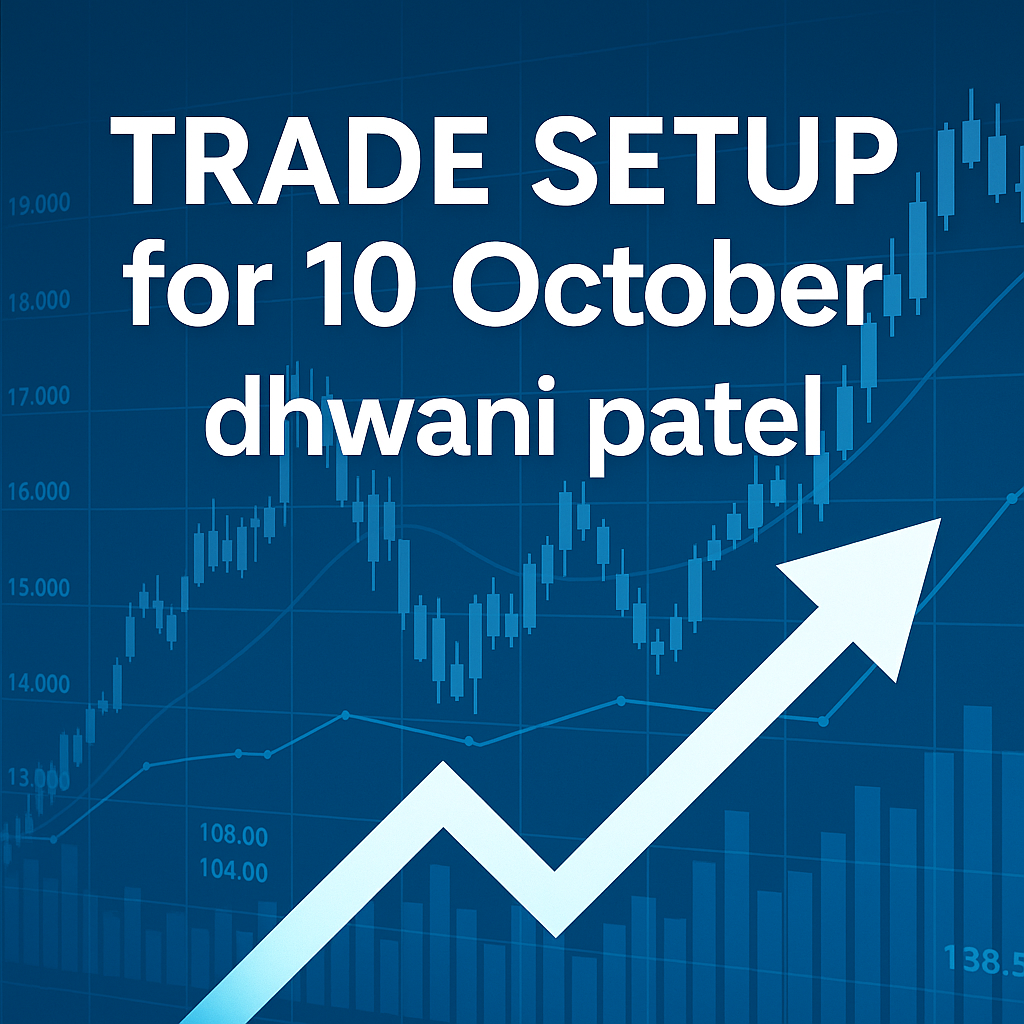
Introduction — quick read before the bell
Markets open and close on many forces: global cues, domestic flows, sector rotation, derivative positioning and investor psychology. For the October 10 session, several technical and flow-based signals deserve attention because they set the intraday and near-term bias for participants. This write-up by dhwani patel distills 10 pragmatic market setups you should watch before the opening bell — explained so you can apply them whether you trade intraday, use index futures, or hold short swing positions.
Where relevant, I reference pre-market data and derivative positioning published by market trackers to make these setups concrete and repeatable. Keep in mind this is analysis to help preparation, not a buy/sell call. All factual market data referenced below is taken from the pre-market market summary published for October 10.
Setup 1 — Nifty: primary battle band to watch (the macro pivot)
What the market said (key levels): If the Nifty manages to reclaim and sustain above 25,200, the immediate targets to watch were 25,350–25,450, provided the index continues to defend 25,000–24,900 as support. These levels were highlighted in the pre-market briefing as the main reference band for the session.
Why it matters: The Nifty band is the structural frame for both index trades and stock selection. When Nifty is inside this band, expect range-bound rotation; a clean breakout or breakdown usually signals a higher-probability directional phase.
How to use it (framework, not a trade call):
- Use the band to set market bias: above it = constructive; below it = cautious/defensive.
- For futures traders: treat it as a reference to tilt position sizing when aligning with an Nifty futures trading guide — increase conviction only with confirmation (volume + OI move).
- For swing traders: prefer buying strength above 25,350 with technical confirmation; avoid hero-sized bets when inside the band.
Setup 2 — Bank Nifty: watching the financial engine
Pre-market read: Bank Nifty’s pivot and resistance levels were noted with pivot-based resistance around 56,276 / 56,381 / 56,550 and pivot supports around 55,938 / 55,834 / 55,665; Fibonacci resistance extended higher near 56,758 / 57,628. The daily chart shows bullish bias but profit booking pockets exist.
Why it matters: Bank Nifty tends to lead or confirm broad market direction. A strong Bank Nifty often pulls other cyclical and financial names higher; a weakness there amplifies market-wide selling.
How traders may frame it:
- Use Bank Nifty as a leading indicator for index futures strategies — if Bank Nifty weakens near resistance while Nifty holds, watch for a sector rotation.
- For intraday: watch the first 30–45 minutes for direction; if Bank Nifty sustains above its pivot cluster on volume, the risk-reward for long index futures setups improves.
Setup 3 — Option chain: where the crowd’s tape is written (Calls)
What the data shows: On the call side, the weekly maxima were concentrated at strikes like 26,000 (1.34 crore contracts), followed by 25,500 (1.03 crore) and 25,200 (98.31 lakh). Heavy call writing was observed at strikes such as 25,400, 25,600 and 25,550 — which can show where short-term sellers are positioning resistance.
Why it matters: Call open interest clusters and addition/ unwinding are visual cues for where professional traders expect or cap upside. For options-sensitive trades, these strikes often become reference points during the session.
Strategy lens (education, not advice):
- If you’re learning from an Nifty futures trading guide, combine call OI clusters with price action to judge whether an upside breakout is genuine or being capped by call sellers.
- For options traders: heavy call writing near a strike can make call buying expensive; consider structured alternatives (verticals/spreads) to manage premium.
Setup 4 — Option chain: where support lies (Puts)
What the data shows: On the put side, the 25,000 strike held the maximum put open interest (≈1.37 crore contracts), followed by strikes like 25,100 and 24,500. This indicates a strong put-support zone near 25,000 — a psychological and technical base the market watched.
Why it matters: Large put concentrations can act as a magnet for price (support) but may also represent sellers hedging. A breach of such a band is often followed by accelerated moves as stop-losses and option positions react.
Trader’s approach:
- Use put clusters as the ‘floor’ to respect for intraday bias. Breaks below such floors require increased caution and risk reduction.
- For swing setups: a successful defence of put-heavy zones can be used as part of an evidence-based entry plan (with proper risk management).
Setup 5 — Bank Nifty options: a separate map for financial trades
Snapshot: Bank Nifty’s OI peaks were at 57,000 (max Call OI) followed by 58,000 and 56,000; maximum Put OI clustered near 55,000. Notably, call writing concentrated at 56,500 and 57,500, pointing to where resistance may be held in the short term.
How to interpret: For traders focused on financials, Bank Nifty options tell a parallel story — where participants expect resistance/support in the banking index. Because banks have outsized weight, these signals can spill into Nifty direction and liquidity.
Tactical note: those using index futures trading strategies India should watch Bank Nifty OI structure for early signs of sector stress or strength.
Setup 6 — Put-Call Ratio & skew: the sentiment thermometer
What it indicates: Put-Call Ratio movements give a sense of directional sentiment. A rising PCR (above historical averages) points to defensive sentiment; the pre-market noted the market’s PCR dynamics and what shifts might imply for intraday bias.
How to use:
- Treat PCR changes as an overlay — a quick rise in PCR pre-open suggests traders are adding protection and that rallies may lack conviction.
- Combine PCR with actual option positioning (OI) to see whether hedges are being built by professionals or amateurs — a big difference in trade interpretation.
Setup 7 — India VIX: complacency vs opportunity
Current reading: India VIX had dropped to the low-teens (~10.12 as reported), remaining below short-term moving averages — this low volatility zone suggests a comfort window for bulls but warns of potential sudden spikes.
Why it’s important: Low VIX means option premiums are cheaper — good for defined risk long strategies but risky if volatility spikes unexpectedly. Conversely, VIX upticks often accompany disorderly moves rather than orderly corrections.
How to act on it (education):
- If VIX is low, prefer structured entries (spreads) or size down and use a clear stop.
- If VIX spikes intraday, consider reducing gross exposure or switch to volatility-sensitive hedges.
Setup 8 — Flow & positioning: long/short builds and the hidden tape
Pre-market reads: The report highlighted a long build-up in 104 stocks, some long unwinding in a few counters, short build-ups in others, and extensive short-covering in many names — essentially a mixed internals snapshot that traders must parse.
Why flows matter: These on-chain OI moves are signs of conviction — long builds with rising prices imply accumulation; long unwinding suggests profit booking. The balance across hundreds of stocks offers context to whether the market is broadening or narrowing.
Actionable lens:
- Scan for stocks with rising OI + rising price for swing trade candidates. These often show institutional interest and fit swing trading strategies India frameworks.
- Conversely, be cautious when OI rises but price falls (short builds) — such names can gap down quickly.
Setup 9 — Delivery & F&O ban list: structural clues for allocation
What the report noted: There were lists of high-delivery trades (stocks showing genuine investor accumulation) and F&O ban status (few changes; RBL Bank retained on the banned list at the time). Stocks under F&O restrictions can behave erratically as fresh positions are limited.
Why this is useful: Delivery-heavy moves indicate long-term buying, which is a stronger signal than intraday buzz. F&O bans and their composition tell you which names to avoid if you need flexible sizing.
How to integrate into your plan:
- Prefer delivery-backed names for multi-day swings — they carry a higher chance of follow-through.
- Avoid placing dependent leveraged bets in F&O-banned counters unless you fully understand the mechanics.
Setup 10 — Macro and global cues: don’t trade in a vacuum
Context: Globally, bond yields, crude prices and US market sessions can pivot flows into India quickly. For October 10, watching global risk indicators remains critical — they often drive FII flows that make or break intraday momentum. (Moneycontrol summarized these macro cues in the pre-market note.)
Why it matters: In an era of fast capital flows, domestic moves are often an echo of global positioning. Traders who ignore this end up fighting higher-probability market tides.
Practical frame: Always check 1–2 global cues (US futures, crude, 10y yield) before placing directional bets or sizing positions.
Putting the 10 setups together — a simple playbook (not a signal)
Below is a short, rules-based framework you can use to convert the above setups into a disciplined process. This is intentionally non-prescriptive and built to avoid SEBI compliance issues — educational and process-oriented.
- Pre-market checklist (15–20 minutes):
- Confirm Nifty relative to 25,200 band and Bank Nifty relative to pivot band.
- Check India VIX (is it low or spiking?).
- Scan option OI hotspots (major calls and puts).
- Bias formation:
- If Nifty > 25,200 and holds, bias = constructive (prefer longs); else: caution. Use call/put OI to refine where upside might be capped or downside supported.
- Entry filter:
- For futures: use breakouts confirmed by volume & OI change. For options: prefer spreads to reduce premium risk. If delivery is high for a stock and OI builds up, it becomes a candidate for a swing plan.
- Risk & size:
- Keep position size smaller when VIX is low but option OI shows concentrated bets — that’s hidden risk. Always size trades so one loss does not derail the week.
- Review & adapt:
- Reassess flows (FII/DII) and sector rotation at midday. If sector leadership shifts, reposition conservatively.
This framework maps to a disciplined trading approach and is consistent with general index futures trading strategies India and swing trading strategies India concepts.
Final words from dhwani patel
“Market setups are a roadmap, not a guarantee. The best traders prepare for multiple scenarios and respect risk,” says dhwani patel, SEBI registered research analyst. Use the 10 setups above to create your checklists, but always combine them with your risk rules and position-sizing discipline.
Disclosure & Disclaimer: dhwani patel (SEBI Registration No. INH200008608) is a SEBI registered research analyst. The views and information provided in this blog are for educational and informational purposes only. This article does not constitute investment advice, a recommendation, or an offer to buy or sell any financial instrument. Market conditions can change quickly; investors and traders should perform their own due diligence or consult their financial advisor before making any investment decisions. SEBI does not endorse or approve any research or advice provided by research analysts.
